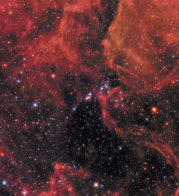The Sun could be surrounded by a flat disc of neutrinos more than a billion times denser than the neutrino cloud permeating the rest of the universe. This is the suggestion from precision measurements of the beta decay of tritium by the Institute of Nuclear Research, Troitsk, Russia, which also give a new upper limit on the electron neutrino mass.
After 1998’s harvest of neutrino evidence underlined the possibility that neutrinos may have mass, neutrino mass is back in the spotlight. Neutrinos are conventionally described as massless particles moving with the speed of light, but a tiny mass introduces interesting possibilities, for both physics and cosmology.
Neutrinos cannot be observed directly. Their job in Nature is to carry off energy in beta decay, and the best way of “observing” them is to keep detailed accounts of particle energy. Any mismatch indicates that an unseen neutrino “thief” has been at work.
Mass measurement is particularly difficult and sensitive for the electron neutrino, the lightest. Zero mass is difficult to prove, and refined experiments successively push down the mass limit. To help with the detailed energy book-keeping, physicists look at the beta decay spectrum of tritium as close as possible to the highest possible energy of the emerging electrons. Although this is only a tiny fraction of the total decays, these conditions provide a long lever arm on the neutrino mass.
The experiment at Troitsk provides a new upper limit of 2.5 eV. If the particle indeed has mass, it is probably only a minute fraction of this value, but in unravelling the data the experiment came across an unexpected effect which at first appeared as a small peak very near to maximum electron energy, which moves up and down by some 10 eV every six months!
It is as though the Sun were surrounded by a dense disc of neutrinos at an angle to the Earth’s orbit. The Earth thus sees a neutrino density which varies over a six-month cycle. A neutrino reacts with a tritium nucleus, producing a helium-3 nucleus and a monochromatic electron seen as a peak in the tritium beta decay spectrum.
The neutrino cloud needs a concentration of 1015 per cubic centimetre, compared to the generally accepted few hundred for background cosmic neutrinos. There is no explanation for such a compact neutrino cloud. Neutrino effects in tritium beta decay have come and gone before, and this one too needs to be checked out.
At the moment only one other operational experiment (Mainz) could reach comparable sensitivity to check the Troitsk observation. A more decisive check could be obtained via a more elaborate setup now being discussed.





